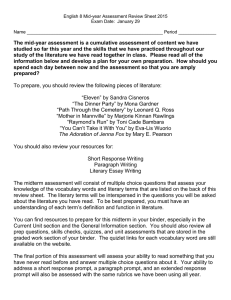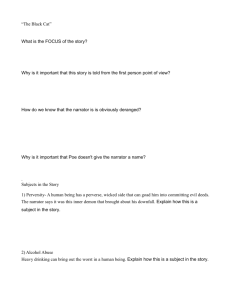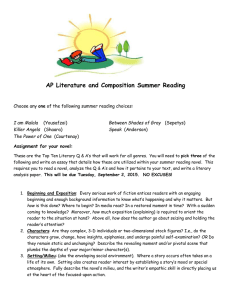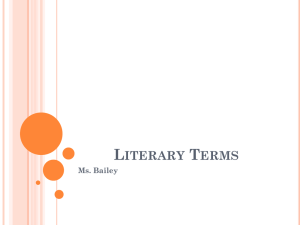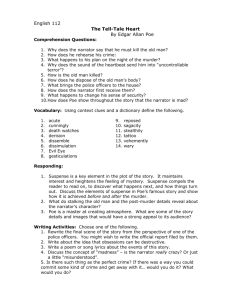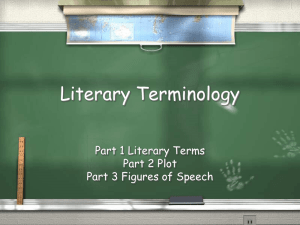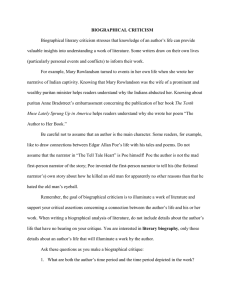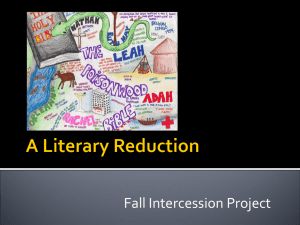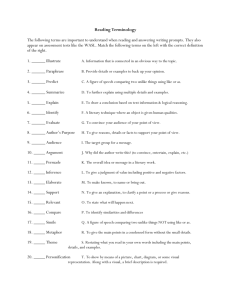“The Interlopers” “The Cask of Amontillado” “Poe's Final Days
advertisement
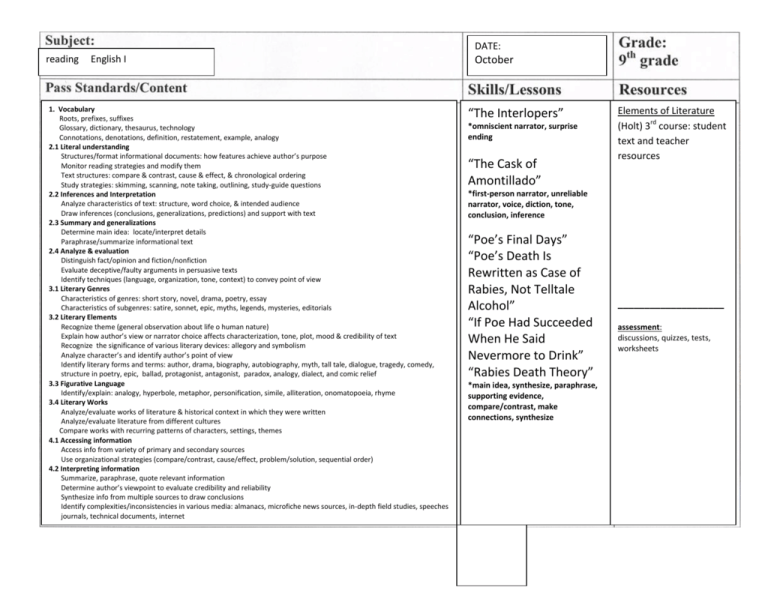
DATE: reading English I 1. Vocabulary Roots, prefixes, suffixes Glossary, dictionary, thesaurus, technology Connotations, denotations, definition, restatement, example, analogy 2.1 Literal understanding Structures/format informational documents: how features achieve author’s purpose Monitor reading strategies and modify them Text structures: compare & contrast, cause & effect, & chronological ordering Study strategies: skimming, scanning, note taking, outlining, study-guide questions 2.2 Inferences and Interpretation Analyze characteristics of text: structure, word choice, & intended audience Draw inferences (conclusions, generalizations, predictions) and support with text 2.3 Summary and generalizations Determine main idea: locate/interpret details Paraphrase/summarize informational text 2.4 Analyze & evaluation Distinguish fact/opinion and fiction/nonfiction Evaluate deceptive/faulty arguments in persuasive texts Identify techniques (language, organization, tone, context) to convey point of view 3.1 Literary Genres Characteristics of genres: short story, novel, drama, poetry, essay Characteristics of subgenres: satire, sonnet, epic, myths, legends, mysteries, editorials 3.2 Literary Elements Recognize theme (general observation about life o human nature) Explain how author’s view or narrator choice affects characterization, tone, plot, mood & credibility of text Recognize the significance of various literary devices: allegory and symbolism Analyze character’s and identify author’s point of view Identify literary forms and terms: author, drama, biography, autobiography, myth, tall tale, dialogue, tragedy, comedy, structure in poetry, epic, ballad, protagonist, antagonist, paradox, analogy, dialect, and comic relief 3.3 Figurative Language Identify/explain: analogy, hyperbole, metaphor, personification, simile, alliteration, onomatopoeia, rhyme 3.4 Literary Works Analyze/evaluate works of literature & historical context in which they were written Analyze/evaluate literature from different cultures Compare works with recurring patterns of characters, settings, themes 4.1 Accessing information Access info from variety of primary and secondary sources Use organizational strategies (compare/contrast, cause/effect, problem/solution, sequential order) 4.2 Interpreting information Summarize, paraphrase, quote relevant information Determine author’s viewpoint to evaluate credibility and reliability Synthesize info from multiple sources to draw conclusions Identify complexities/inconsistencies in various media: almanacs, microfiche news sources, in-depth field studies, speeches journals, technical documents, internet October “The Interlopers” *omniscient narrator, surprise ending “The Cask of Amontillado” Elements of Literature (Holt) 3rd course: student text and teacher resources *first-person narrator, unreliable narrator, voice, diction, tone, conclusion, inference “Poe’s Final Days” “Poe’s Death Is Rewritten as Case of Rabies, Not Telltale Alcohol” “If Poe Had Succeeded When He Said Nevermore to Drink” “Rabies Death Theory” *main idea, synthesize, paraphrase, supporting evidence, compare/contrast, make connections, synthesize ____________________ assessment: discussions, quizzes, tests, worksheets

